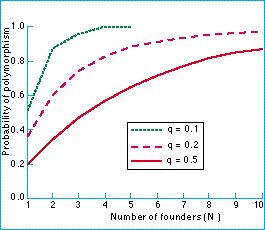Founder effect

The founder effect is a particular example of the influence of random sampling. It was defined by Ernst Mayr as:
"The establishment of a new population by a few original founders (in an extreme case, by a single fertilized female) which carry only a small fraction of the total genetic variation of the parental population."
A population may be descended from a small number of ancestral individuals for two reasons:
• A small number of individuals may colonize a place previously uninhabited by their species. The 250 people making up the human population on the island of Tristan da Cunha, are mostly descended from one Scottish family who arrived in 1817.
• An established population may fluctuate in size: the founder effect occurs when the population passes through a 'bottleneck' in which only a few individuals survive, and later expands again under more favorable conditions.
The founder effect can have two interesting consequences:
• If a small sample of individuals is taken from a larger population, there is a chance that an allele will be lost. In the case of two alleles, A and a, if the founding population are all aa homozygous then the A allele will be lost and the new population will be genetically monomorphic. In fact, the founding effect is quite ineffective at reducing genetic variation - even if the founding population is very small, even less than 10, it will usually possess both alleles.
• In a small sample, the frequencies of the genes may differ from the parental population. Isolated populations often have exceptionally high frequencies of otherwise rare alleles, and the most likely explanation is that the founding population had a disproportionate number of those rare alleles. The frequency of Huntington's disease in South Africa is a good example of this.
The founder effect is illustrated by an animation.
Figure: the chance that a founder population will be homozygous depends on the number of founders and the gene frequencies. Here, the chance of homozygosity (= 1 - probability of polymorphism) is shown for three different gene frequencies (q) at a two-allele locus.
| Next |



